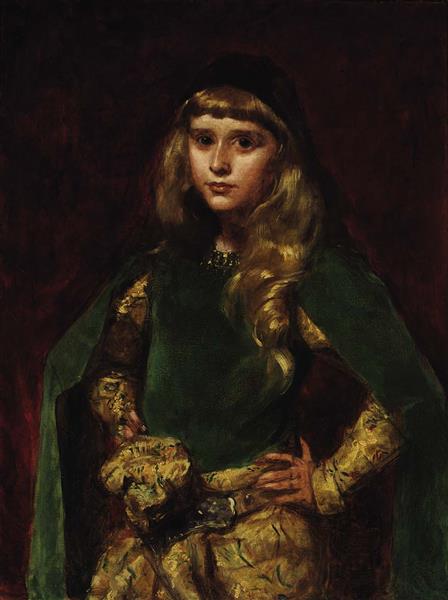
Young Bohémienne: Natalie Clifford Barney (1875–1972) at the Age of 10
The word “bohémien(ne)” was first associated with artistic, countercultural people in 1800s France. The association is confusing because the word “bohémien(ne)” or “bohemian” actually refers to three (fairly) distinct groups of people. Firstly, the word refers to Bohemia, an actual region that sat within modern day Czechia. Secondly, the word referred to the Romani people who were associated with that region (despite having migrated from modern day Northern India). Thirdly, the term has come to describe numerous countercultural groups in Europe and America, and their aesthetics, over the past 200 years.
For clarity’s sake, in this blog post “bohemian” will refer to adopters of the bohemian aesthetic. The word “Romani” will refer to the Romani people. The geographic region of Bohemia won’t come up again.
Early adopters of the bohemian aesthetic cut against the grain of their contemporaries with their free-spirited lifestyle and loose fitting, eccentric clothing. They were inspired by the romantic movement of that era, which valued the perspective and emotion of the artist over objective reality. Early bohemianism could even be seen as the lifestyle equivalent (or close equivalent) to Romanticism. They also took much inspiration (see also: appropriated) from the Romani people, and stereotypes associated with them. As will be later discussed, cultural appropriation has been a recurring trend within this aesthetic.
Modern bohemianism was most notably influenced by beat and hippie culture of the 20th century. Like early bohemians, these subcultures wished to rebel against the limiting social structures of their day. The modern bohemian value of connection with the earth is shared by hippie culture.

A Couple Attending the Woodstock Music Festival Smiles While Standing Outside the Shelter They’ve Built during the Concert
Some famous contributors to the bohemian aesthetic include artist Vincent Van Gogh, author Jack Kerouac, and singer-songwriter Willie Nelson. Giacomo Puccini’s 1896 opera La Bohème also notably portrays the life of impoverished bohemian artists. It isn’t a stretch to say the expression “starving artist” is derived from such a lifestyle.

La Bohème Poster

Willie Nelson Performs during Farm Aid 2009 in St. Louis, MO
The modern bohemian aesthetic is defined by several characteristics. Blues, greens, and earth tones are the most common color palette. These represent a connection between the wearer and the earth. Compared to other modern aesthetics, bohemian favors detailed, elaborate patterns including paisley, floral, or geometric. Organic elements like plants or wooden objects are popular in addition to visibly handmade objects, especially those made by the owner. Loose fitting, comfortable, and/or eccentric clothing have remained common since the aesthetic’s inception.


Modern Bohemian Dress
Sadly, the history of the bohemian aesthetic is fraught with cultural appropriation. True (sort of) to their name, early bohemians appropriated the lifestyle and visual elements of Romani culture. At that time the stereotype of the nomadic, free-spirited Romani was simultaneously disdained and fetishized. Today, many other non-white or non-Western European cultures are appropriated in the bohemian aesthetic as well. Indian, American Indigenous, and even Eastern/Central European cultures often find their way into bohemian lifestyles without regard for their origin.
Aesthetics can serve many purposes. Cultural aesthetics in particular have the ability to tie an individual to other members of that culture, both past and present. Since the bohemian aesthetic has historically been counter-cultural, it often serves the opposite purpose: to distance individuals from the mainstream culture around them. It’s interesting that in that effort, many turn to the aesthetics of other peoples, not to thoughtfully engage in them, but to leave behind the aesthetics of their own people.
Sources
Andy Walker. “What Is Bohemian?” BBC News, March 11, 2011, sec. Magazine. https://www.bbc.com/news/magazine-12711181.
“Bohemian.” Aesthetics Wiki, August 4, 2019. https://aesthetics.fandom.com/wiki/Bohemian.
“Bohemian Style.” In Wikipedia, January 27, 2023. https://en.wikipedia.org/w/index.php?title=Bohemian_style&oldid=1135878487.
Mehar. “Bohemian Fashion: History and Boho Aesthetics.” Accessed January 30, 2023. https://www.mehar.xyz/india/blog/bohemian-fashion-history-and-boho-aesthetics.
Images
Adolfo Hohenstein. La Bohème Poster. 1896. https://upload.wikimedia.org/wikipedia/commons/7/70/La_Boheme_poster_by_Hohenstein.PNG.
Aubrie Evans. What to Pack: Honeymoon Essentials. May 20, 2015. Photograph. https://bldg25blog.wpenginepowered.com/wp-content/uploads/2015/05/honeymoon8s.jpg.
Audrie Storme. n.d. Photograph. https://static.wikia.nocookie.net/aesthetics/images/4/44/The_10_best_bohemian_bloggers_on_Instagram_you_need_to_follow%21.jpeg/revision/latest?cb=20201216235657.
Carolus-Duran. Young Bohémienne: Natalie Clifford Barney (1875–1972) at the Age of 10. 1887. Painting. https://en.wikipedia.org/wiki/Bohemian_style#/media/File:Carolus-Duran—Natalie-at-.jpg.
Ralph Ackerman. A Couple Attending the Woodstock Music Festival Smiles While Standing Outside the Shelter They’ve Built during the Concert. 1969. Photograph. https://www.timesunion.com/blogs/slideshow/Woodstock-1969-91667.php.
Taylor Hill. Willie Nelson Performs during Farm Aid 2009 in St. Louis, Mo. 2009. Photograph. https://media.npr.org/assets/artslife/arts/2010/08/fresh-air-country-music-week/willie-nelson/willie-nelson-259a2127f4e9f703c430ad9d150e72299c7cad42-s1100-c50.jpg.


2 Comments. Leave new
Very thoughtful post! As a fan of Romani music and dance, I appreciate your sensitivity to cultural appropriation. Like harassment, I wonder if it is best defined by how it is meant, or how it is perceived. (Comment at 7:47 pm)
I wonder the same thing. As someone outside of Romani culture, I don’t know if I really have a good answer to that question.
Growing up, my family was quite racist against Romani people. My grandmother (whose parents had emigrated from Slovakia) would use the G-slur casually and frequently. She painted a derisive picture of Romani culture in my mind and I didn’t realize until college how offensive (and frankly inaccurate) it was. That was in part what peaked my interest in this specific aesthetic.
Your comment also reminds me of an interview I recently read with Robert Gábriš, a Prague/Bratislava based Roma artist whose work deals with the Roma community, among other things. It’s a great read (It’s in Slovak so you’ll need to translate the page!) but as a warning it contains quite a lot of explicit artwork.
https://duhovyrok.sk/qys/robert-gabris-zaoberam-sa-socialno-kritickym-umenim-hlavne-romskou-komunitou-problematikou-identit-tela-etnicity-nacionality-ale-aj-lgbt-a-queer-komunitou/